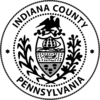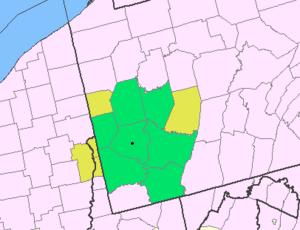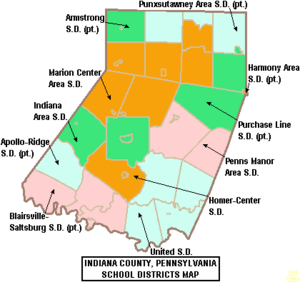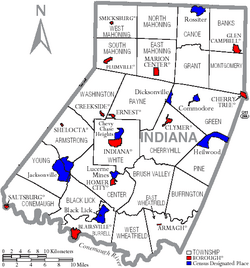Indiana County, Pennsylvania facts for kids
Quick facts for kids
Indiana County
|
||
|---|---|---|
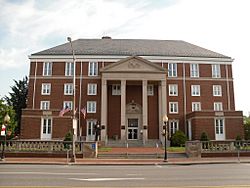
Indiana County Courthouse
|
||
|
||
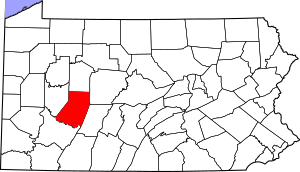
Location within the U.S. state of Pennsylvania
|
||
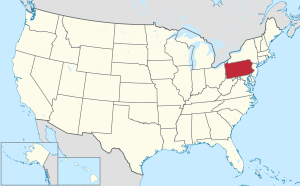 Pennsylvania's location within the U.S. |
||
| Country | ||
| State | ||
| Founded | November 3, 1806 | |
| Seat | Indiana | |
| Largest borough | Indiana | |
| Area | ||
| • Total | 834 sq mi (2,160 km2) | |
| • Land | 827 sq mi (2,140 km2) | |
| • Water | 7.3 sq mi (19 km2) 0.9% | |
| Population
(2020)
|
||
| • Total | 83,246 | |
| • Density | 101/sq mi (39/km2) | |
| Time zone | UTC−5 (Eastern) | |
| • Summer (DST) | UTC−4 (EDT) | |
| Congressional district | 15th | |
Indiana County is a county in the Commonwealth of Pennsylvania. It is located in the west central part of Pennsylvania. As of the 2020 census, the population was 83,246. Its county seat is Indiana. Indiana County comprises the Indiana, PA Micropolitan Statistical Area, which is also included in the Pittsburgh-New Castle-Weirton, PA-WV-OH Combined Statistical Area. The county is part of the Southwest Pennsylvania region of the state.
Prior to the Revolutionary War, some settlers proposed this as part of a larger, separate colony to be known as Vandalia, but opposing interests and the war intervened. Afterward, claims to the territory by both the states of Virginia and Pennsylvania had to be reconciled. After this land was assigned to Pennsylvania by the federal government according to the placement of the Mason–Dixon line, Indiana County was created on March 30, 1803, from parts of Westmoreland and Clearfield counties and was formally organized in 1806.
Contents
History
Indiana County (Indiana meaning "land of the Indians") derives its name from the so-called "Indiana Grant of 1768" that the Iroquois Six Nations were forced to make to "suffering traders" under the Fort Stanwix Treaty of 1768. The Iroquois had controlled much of the Ohio River valley as their hunting grounds since the 17th century, and Anglo-American colonists were moving into the area and wanted to develop it. Traders arranged to force the Iroquois to grant land under the treaty in relations to losses due to Pontiac's Rebellion.
Some of the grantees joined forces with the Ohio Company, forming a larger development company based on enlarging their grant of land. They proposed that the entire large area would become a new British colony, possibly to be called Pittsylvania or Vandalia. It was to be bordered on the north and west by the Ohio River, and made up of what are now parts of eastern Kentucky, northern West Virginia (then part of the Virginia Colony), and western Pennsylvania. Anglo-European colonists from Virginia and Pennsylvania had already started to move into the area, which was identified by these various names as Indiana and the other above names on some maps of the late 1700s.
Opposition from other interest groups and the American Revolutionary War intervened before Britain approved such a colony. Afterward, some United States speculators proposed setting up a state in this area to be called Vandalia, or Westsylvania, as appears on some maps of the period.
But both the states of Virginia and Pennsylvania claimed the land based on their colonial charters. In establishing the Mason–Dixon line, the federal government assigned the Indiana Grant to Pennsylvania. As population increased after the war, this county was made up in 1803 of territory from Westmoreland and Clearfield counties; it was formally organized in 1806.
Kentucky and West Virginia continued to be associated with Virginia for some time, being separately admitted as states in the early 19th century and during the American Civil War, respectively. The area in Pennsylvania was unrelated to and was physically separated from the later named Indiana Territory established north of the Ohio River in 1800 by the new United States; that territory was eventually admitted to the Union as the State of Indiana.
Indiana County was known as a "hotbed of abolition", and was home to at least two African Methodist Episcopal Zion churches as well as other anti-slavery Protestants such as Wesleyan Methodists and Baptists. It was also in Indiana, local abolitionist leader James Moorhead published several anti-slavery newspapers. The first of these was The Clarion of Freedom, founded in 1843. Moorhead eventually sold the Clarion and founded a new anti-slavery paper, the Indiana Independent, which he published until his death in 1857. The Independent was published by his son J. W. Moorhead after his death. Blairsville was home to another abolitionist newspaper, The Appalachian, which was pro-Free Soil from 1848. Some of the nearby anti-slavery families like the Mitchells and Van Leers, became conductors or contributors in 1958. In a letter to abolitionist Theodore Parker, a local geologist Peter Lesley stated there we over 3,000 men helping the railroad in the area.
Indiana County was an active hub of the Underground Railroad. At least 90 county residents are known to have been conductors or agents, guiding fugitive slaves between hiding places on their way to freedom in Canada.
In the 21st century, Indiana County comprises the Indiana, PA Micropolitan Statistical Area. This is included in the Pittsburgh-New Castle-Weirton, PA-WV-OH Combined Statistical Area. It is in the defined region of the Pittsburgh media market. Indiana County is served by three different area codes: 724, 814, and 582.
The county proclaims itself the "Christmas Tree Capital of the World", shipping over one million trees annually. Agriculture is a major part of its economy.
Geography
According to the U.S. Census Bureau, the county has a total area of 834 square miles (2,160 km2), of which 827 square miles (2,140 km2) is land and 7.3 square miles (19 km2) (0.9%) is water. Located in the county is the Buttermilk Falls Natural Area. The county has a humid continental climate which is warm-summer, (Dfb) except along the Conemaugh, from below Strangford and the Kiskiminetas River, where it is hot-summer (Dfa). Average monthly temperatures in the borough of Indiana range from 27.2 °F in January to 70.9 °F in July. Indiana County is one of the 423 counties served by the Appalachian Regional Commission, and it is identified as part of the "Midlands" by Colin Woodard in his book American Nations: A History of the Eleven Rival Regional Cultures of North America.
Adjacent counties
- Jefferson County (north)
- Clearfield County (northeast)
- Cambria County (southeast)
- Westmoreland County (south)
- Armstrong County (west)
Major highways
| Historical population | |||
|---|---|---|---|
| Census | Pop. | %± | |
| 1810 | 6,214 | — | |
| 1820 | 8,882 | 42.9% | |
| 1830 | 14,252 | 60.5% | |
| 1840 | 20,782 | 45.8% | |
| 1850 | 27,170 | 30.7% | |
| 1860 | 33,687 | 24.0% | |
| 1870 | 36,138 | 7.3% | |
| 1880 | 40,527 | 12.1% | |
| 1890 | 42,175 | 4.1% | |
| 1900 | 42,556 | 0.9% | |
| 1910 | 66,210 | 55.6% | |
| 1920 | 80,910 | 22.2% | |
| 1930 | 75,395 | −6.8% | |
| 1940 | 79,854 | 5.9% | |
| 1950 | 77,106 | −3.4% | |
| 1960 | 75,366 | −2.3% | |
| 1970 | 79,451 | 5.4% | |
| 1980 | 92,281 | 16.1% | |
| 1990 | 89,994 | −2.5% | |
| 2000 | 89,605 | −0.4% | |
| 2010 | 88,880 | −0.8% | |
| 2020 | 83,246 | −6.3% | |
 US 22
US 22 US 119
US 119 US 219
US 219 US 422
US 422


 US 422 Bus.
US 422 Bus. PA 36
PA 36 PA 56
PA 56 PA 85
PA 85 PA 110
PA 110 PA 156
PA 156 PA 210
PA 210 PA 217
PA 217 PA 240
PA 240 PA 259
PA 259 PA 286
PA 286 PA 403
PA 403 PA 553
PA 553 PA 580
PA 580 PA 711
PA 711 PA 954
PA 954
Demographics
As of the census of 2000, there were 89,605 people, 34,123 households, and 22,521 families residing in the county. The population density was 108 inhabitants per square mile (42/km2). There were 37,250 housing units at an average density of 45 units per square mile (17/km2). The racial makeup of the county was 96.87% White, 1.57% Black or African American, 0.08% Native American, 0.74% Asian, 0.01% Pacific Islander, 0.16% from other races, and 0.58% from two or more races. 0.51% of the population were Hispanic or Latino of any race. 25.9% were of German, 11.6% Italian, 10.7% Irish, 8.6% American, 7.1% English and 6.8% Polish ancestry.
There were 34,123 households, out of which 27.90% had children under the age of 18 living with them, 54.30% were married couples living together, 8.20% had a female householder with no husband present, and 34.00% were non-families. 26.50% of all households were made up of individuals, and 11.80% had someone living alone who was 65 years of age or older. The average household size was 2.47 and the average family size was 2.99.
In the county, the population was spread out, with 21.10% under the age of 18, 16.60% from 18 to 24, 24.80% from 25 to 44, 22.70% from 45 to 64, and 14.90% who were 65 years of age or older. The median age was 36 years. For every 100 females, there were 94.00 males. For every 100 females age 18 and over, there were 90.60 males.
2020 census
| Race | Num. | Perc. |
|---|---|---|
| White (NH) | 75,718 | 91% |
| Black or African American (NH) | 2,409 | 2.9% |
| Native American (NH) | 116 | 0.14% |
| Asian (NH) | 816 | 1% |
| Pacific Islander (NH) | 7 | 0.01% |
| Other/Mixed (NH) | 2,704 | 3.25% |
| Hispanic or Latino | 1,476 | 1.77% |
Micropolitan Statistical Area
The United States Office of Management and Budget has designated Indiana County as the Indiana, PA Micropolitan Statistical Area (μSA). As of the 2010 U.S. Census the micropolitan area ranked 4th most populous in the State of Pennsylvania and the 50th most populous in the United States with a population of 88,880. Indiana County is also a part of the Pittsburgh-New Castle-Weirton, PA-OH-WV Combined Statistical Area (CSA), which combines the population of Indiana, as well as the Allegheny, Armstrong, Beaver, Butler, Fayette, Lawrence, Washington and Westmoreland county areas in Pennsylvania. In West Virginia the counties included are Brooke and Hancock. And in Ohio, Jefferson County. The Combined Statistical Area ranked 4th in the State of Pennsylvania and 20th most populous in the United States with a population of 2,660,727.
Education
Public school districts
School districts include:
- Armstrong School District (part)
- Apollo-Ridge School District (part)
- Harmony Area School District (part)
- Homer-Center School District
- Indiana Area School District
- Marion Center Area School District
- Penns Manor Area School District
- Punxsutawney Area School District (part)
- Purchase Line School District (part)
- River Valley School District formerly Blairsville-Saltsburg School District
- United School District
Post-secondary education
- Indiana University of Pennsylvania – Indiana
- Westmoreland County Community College – Indiana
Environment
In 2003, the county was recommended for non-attainment under EPA ozone standards based upon mobile source contribution to smog-forming emissions.
The county is the site of the Homer City Generating Station, a coal-burning power plant. In 2002 the plant was ranked as second in emissions in the Toxics Release Inventory (TRI) in Pennsylvania. In 2003, the plant ranked high in the emissions of both sulfur dioxide and carbon dioxide, ranking 4th and 28th, respectively, in the nation. Such toxic emissions are injurious to people and other living things.
Communities
Under Pennsylvania law, there are four types of incorporated municipalities: cities, boroughs, townships, and, in at most two cases, towns. The following boroughs and townships are located in Indiana County:
Boroughs
Townships
- Armstrong
- Banks
- Black Lick
- Brush Valley
- Buffington
- Burrell
- Canoe
- Center
- Cherryhill
- Conemaugh
- East Mahoning
- East Wheatfield
- Grant
- Green
- Montgomery
- North Mahoning
- Pine
- Rayne
- South Mahoning
- Washington
- West Mahoning
- West Wheatfield
- White
- Young
Census-designated places
Census-designated places are geographical areas designated by the U.S. Census Bureau for the purposes of compiling demographic data. They are not actual jurisdictions under Pennsylvania law. Other unincorporated communities, such as villages, may be listed here as well.
Unincorporated communities
Population ranking
The population ranking of the following table is based on the 2010 census of Indiana County.
* county seat
| Rank | City/Town/etc. | Municipal type | Population (2010 Census) |
|---|---|---|---|
| 1 | * Indiana | Borough | 13,975 |
| 2 | Blairsville | Borough | 3,412 |
| 3 | Homer City | Borough | 1,707 |
| 4 | Chevy Chase Heights | CDP | 1,502 |
| 5 | Black Lick | CDP | 1,462 |
| 6 | Clymer | Borough | 1,357 |
| 7 | Lucerne Mines | CDP | 937 |
| 8 | Saltsburg | Borough | 873 |
| 9 | Heilwood | CDP | 711 |
| 10 | Rossiter | CDP | 646 |
| 11 | Jacksonville | CDP | 637 |
| 12 | Robinson | CDP | 614 |
| 13 | Dixonville | CDP | 467 |
| 14 | Ernest | Borough | 462 |
| 15 | Marion Center | Borough | 451 |
| 16 | Cherry Tree | Borough | 364 |
| 17 | Commodore | CDP | 331 |
| 18 | Coral | CDP | 325 |
| 19 | Creekside | Borough | 309 |
| 20 | Plumville | Borough | 307 |
| 21 | Graceton | CDP | 257 |
| 22 | Glen Campbell | Borough | 245 |
| 23 | Shelocta | Borough | 130 |
| 24 | Armagh | Borough | 122 |
| 25 | Smicksburg | Borough | 46 |
Notable people
- Edward Abbey, environmentalist and author
- Henry Homer "Doc" Gessler, professional baseball player and manager; born and died in Indiana Borough.
- James H. Brady, Governor of Idaho 1909–11, U.S. Senator 1913–18, born in Indiana County
- John Buccigross, ESPN anchor, former co-host of NHL 2Night
- Samuel Kier, "Grandfather of the American Oil Industry"
- Mary D. Lowman, one of first women mayors in Kansas; county native
- Ben McAdoo, former head coach, New York Giants
- Jim Nance, football player, running back for Syracuse University and professionally with New England/Boston Patriots
- James Stewart, iconic actor, born in Indiana Borough
See also
 In Spanish: Condado de Indiana para niños
In Spanish: Condado de Indiana para niños


